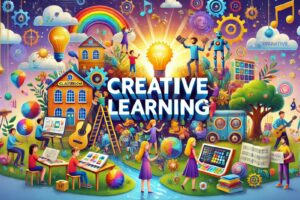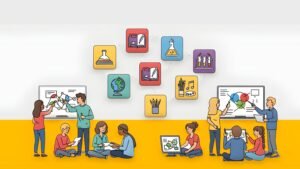Understanding Play-Based Learning
Play-based learning is an educational approach that utilizes play as a crucial component in facilitating the learning process. Its origins can be traced back to early childhood education, where the significance of play was recognized as essential for cognitive and social development. The foundational concept of play-based learning posits that children engage more effectively with their environment when they are allowed to explore, experiment, and interact freely. This approach emphasizes active participation, making learning an exciting and engaging experience.
Key principles underpinning play-based learning include the notion that play is a natural context for learning, the importance of child choice, and the role of the educator in facilitating experiences rather than directing them. Research in developmental psychology and education reinforces the idea that play promotes essential skills such as critical thinking, problem-solving, creativity, and interpersonal communication. By engaging in both free play and structured play, children can hone these abilities in a way that is enjoyable and meaningful to them.
Free play refers to unstructured, child-initiated activities that allow individuals to take the lead, fostering their imagination and creativity. This type of play encourages exploration without specific goals, which nurtures self-directed learning. On the other hand, structured play involves guided activities with specific outcomes, allowing educators to set the stage for targeted learning objectives. Both forms of play serve distinct purposes in a child’s educational journey and can be effectively employed in various educational settings to enhance learning experiences.
Through the lens of theoretical frameworks—such as Piagetian theories of cognitive development and Vygotskian principles surrounding social learning—educators can appreciate the effectiveness of play-based methodologies. These frameworks provide insights into how play supports the holistic development of children, making a strong case for its continued integration into educational practices.
The Rise of Activity-Based Learning
Activity-based learning (ABL) has emerged as a distinct yet complementary approach to play-based learning, emphasizing engaged learning through hands-on experiences. This methodology centers on the idea that learners are not passive recipients of information but active participants in their educational journey. By integrating real-world problem-solving tasks and tangible activities, ABL fosters an environment where students can explore concepts and practice skills in a meaningful context.
Engagement is a cornerstone of activity-based learning. The method encourages educators to implement a variety of activities, such as group projects, experiments, simulations, and role-playing scenarios. These activities are designed to engage learners actively, stimulate critical thinking, and promote collaboration among peers. Through these interactive experiences, students are not only able to grasp theoretical concepts better, but they also develop valuable life skills such as teamwork, communication, and adaptability.
Research supports the efficacy of activity-based learning strategies in improving educational outcomes. Studies have shown that students exposed to ABL demonstrate enhanced retention of knowledge, increased motivation, and improved problem-solving abilities compared to traditional learning models. For instance, a case study conducted within a science classroom revealed that students participating in a hands-on experiment achieved significantly higher test scores than their counterparts who learned through lectures alone. This evidence underscores the potential of ABL to transform classroom dynamics and enhance the overall learning experience.
Moreover, activity-based learning methodologies are versatile, allowing for adaptation across various subjects and age groups. Educators can tailor the activities to their specific learning objectives and student needs, ensuring that the approach remains relevant and impactful. This adaptability further solidifies ABL as a viable teaching strategy that can enrich the educational landscape, facilitating deeper understanding and engagement among learners.
Integrating Play and Activity-Based Learning in the Curriculum
Integrating play-based and activity-based learning methodologies into the curriculum presents numerous opportunities for enhancing student engagement and fostering a deeper understanding of academic concepts. Educators can design curricula that recognize and embrace the strengths of both methodologies by employing several key principles that focus on flexibility, alignment of educational goals, and an emphasis on experiential learning.
First and foremost, creating flexible learning environments is crucial for the successful integration of these approaches. Classrooms should be designed to facilitate movement and exploration, allowing students to interact with their peers and their surroundings. This can be achieved through the arrangement of furniture to create open spaces for group activities, or by incorporating different learning stations that promote various forms of play. Such environments motivate students to participate actively in their learning journey, thereby adjusting the flow of the lesson according to the interests and responses of the learners.
Moreover, aligning educational goals with playful exploration is essential for ensuring that play-based and activity-based learning remains purposeful. Educators can set specific learning outcomes while allowing students the freedom to choose how they demonstrate their understanding. For instance, students may explore mathematical concepts through interactive games, where they can manipulate physical objects to solve problems. This not only reinforces the content but also underscores the importance of discovery and inquiry in the learning process.
Finally, assessing student learning within these methodologies requires innovative evaluation techniques. Traditional assessment methods may not effectively capture the nuanced learning experiences that occur during playful and activity-based lessons. Instead, educators can consider employing formative assessments such as observations, self-assessments, and peer evaluations, which reflect the exploratory nature of play. These strategies encourage students to reflect on their learning, thereby promoting deeper comprehension and retention of knowledge.
Future Directions and Challenges
The future of play-based and activity-based learning methodologies presents both opportunities and challenges as educators strive to adapt to an evolving educational landscape. One notable trend is the integration of technology within these methodologies. Educators are increasingly leveraging digital tools to enhance interactive experiences, tailoring instruction to meet the diverse needs of students. For example, educational apps and virtual simulations can complement traditional play-based activities, fostering deeper engagement and personalized learning pathways. However, as technology becomes more prevalent in classrooms, it is crucial to ensure that these tools serve as enhancements rather than distractions, maintaining the intrinsic value of play in learning.
Societal and cultural shifts also play a significant role in shaping play and activity-based learning. As diversity in classrooms increases, understanding various cultural perspectives on play becomes essential. It is important for educators to incorporate culturally relevant activities that resonate with all students, promoting inclusivity and engagement. Furthermore, collaboration with families and communities can enrich the learning experience by tying lessons to real-world contexts, making learning more relevant and impactful.
Teacher training is another critical component in the advancement of these methodologies. Educators must be equipped with effective strategies for integrating play and activity-based learning into rigid curricula. This calls for professional development programs that provide teachers with the necessary skills and knowledge to implement these methodologies effectively while navigating potential challenges such as curriculum constraints and the pressures of standardized testing. By fostering a deeper understanding of the benefits of play and activity, teachers can advocate for more flexible approaches that prioritize student engagement over rote memorization.
In conclusion, while the future of play-based and activity-based learning methodologies is promising, it is essential to recognize and address the challenges that lie ahead. By embracing technological advancements, understanding cultural dynamics, and prioritizing comprehensive teacher training, educators can create enriched learning environments that truly promote holistic student development.





















